Wanli Emperor
The Wanli Emperor (simplified Chinese: 万历帝; traditional Chinese: 萬曆帝; pinyin: Wànlì Dì; 4 September 1563 – 18 August 1620), personal name Zhu Yijun (Chinese: 朱翊鈞; pinyin: Zhū Yìjūn), was the 14th Emperor of the Ming dynasty, reigned from 1572 to 1620. "Wanli", the era name of his reign, literally means "ten thousand calendars". He was the third son of the Longqing Emperor. His reign of 48 years (1572–1620) was the longest among all the Ming dynasty emperors[1] and it witnessed several successes in his early and middle reign, followed by the decline of the dynasty as the emperor withdrew from his active role in government around 1600.
| Wanli Emperor 萬曆帝 | |||||||||||||||||
|---|---|---|---|---|---|---|---|---|---|---|---|---|---|---|---|---|---|
.jpg.webp) | |||||||||||||||||
| Emperor of the Ming dynasty | |||||||||||||||||
| Reign | 19 July 1572 – 18 August 1620 | ||||||||||||||||
| Enthronement | 19 July 1572 | ||||||||||||||||
| Predecessor | Longqing Emperor | ||||||||||||||||
| Successor | Taichang Emperor | ||||||||||||||||
| Regents | See list
| ||||||||||||||||
| Born | 4 September 1563 (嘉靖四十二年 八月 十七日; Jiajing 42, 17th day of the 8th month) Shuntian Prefecture, North Zhili | ||||||||||||||||
| Died | 18 August 1620 (aged 56) (萬曆四十八年 七月 二十一日; Wanli 48, 21st day of the 7th month) Hongde Hall, Forbidden City | ||||||||||||||||
| Burial | Dingling Mausoleum, Ming tombs, Beijing | ||||||||||||||||
| Consorts | Empress Xiaoduanxian
(m. 1578; died 1620)Empress Dowager Xiaojing
(m. 1578; died 1611)Grand Empress Dowager Xiaoning
(m. 1581–1620)Grand Empress Dowager Xiaojing
(died 1597) | ||||||||||||||||
| Issue |
| ||||||||||||||||
| |||||||||||||||||
| House | Zhu | ||||||||||||||||
| Dynasty | Ming | ||||||||||||||||
| Father | Longqing Emperor | ||||||||||||||||
| Mother | Empress Dowager Xiaoding | ||||||||||||||||
| Wanli Emperor | |||||||
|---|---|---|---|---|---|---|---|
| Traditional Chinese | 萬曆帝 | ||||||
| Simplified Chinese | 万历帝 | ||||||
| Literal meaning | "Ten Thousand Calendars" Emperor | ||||||
| |||||||
Early reign (1572–1582)
Zhu Yijun ascended the throne at the age of eight and adopted the regnal name "Wanli", thus he is historically known as the Wanli Emperor. For the first ten years of his reign, he was aided by a notable statesman, Zhang Juzheng, who governed the country as Wanli's regent. During this period, the Wanli Emperor deeply respected Zhang as a mentor and a valued minister. Archery competitions, equestrianism and calligraphy were some of the pastimes of Wanli.[2] Shortly after Wanli's ascension, a new star appeared in the sky, and Zhang warned him to consider his misbehaviour, as was tradition with the appearance of new stars in the sky, which was considered to be a bad omen.[3] It is generally agreed that this 'new star' was SN 1572, a supernova observed independently by many individuals across the globe.
As Zhang Juzheng was appointed Senior Grand Secretary (Shǒufǔ) in 1572, he launched a reform by the name of "abiding by ancestors' rules". He started from rectifying administration with a series of measures such as reducing redundant personnel and enhancing assessment of officials' performance. This improved officials' quality and efficiency of administration, and based on such facts he launched relevant reforms in the fields of land, finance, and military affairs. In essence, Zhang Juzheng's reform was a rectification of social maladies without offending the established political and fiscal system of the Ming dynasty. Although it did not eradicate political corruption and land annexation, it positively relieved social contradictions. More over, Zhang efficiently protected the dynasty from Japan не, Jurchens and Mongols so he could save national defense expenditure. By the 1580s, Zhang stored an astronomical amount of silver, worth 10 years of the state's total tax revenue. The first ten years of Wanli's regime led to a renaissance, economically, culturally and militarily, an era known in historiography as the Wanli Restoration (萬曆中興).
During the first ten years of the Wanli era, the Ming dynasty's economy and military power prospered in a way not seen since the Yongle Emperor and the Reign of Ren and Xuan from 1402 to 1435. After Zhang's death, the Wanli Emperor felt free to act independently, and reversed many of Zhang's administrative improvements. In 1584, the Wanli Emperor issued an edict confiscating all of Zhang's personal wealth and purging his family members. Especially after 1586 when he had conflicts with ministers about his heir, Wanli decided to not hold the council for 20 years. The Ming dynasty's decline began in the interim.
Middle reign (1582–1600)
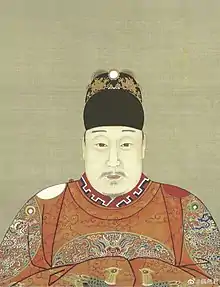
After Zhang Juzheng's death, the Wanli Emperor decided to take complete personal control of the government. During this early part of his reign, he showed himself to be a competent and diligent emperor. Overall, the economy continued to prosper and the empire remained powerful. Unlike the last 20 years of his reign, the Wanli Emperor at this time would attend court and discuss affairs of state.

The first 18 years of the Wanli era would be dominated by three military campaigns:
- Ningxia campaign: In the northern frontier regions, a Ming general rebelled and allied with the Mongols to attack the Ming Empire. The Wanli Emperor sent his troops to deal with the situation, resulting in overall success.
- Korean campaign: Toyotomi Hideyoshi of Japan sent 200,000 soldiers in his first expedition to invade Korea. The Wanli Emperor made three strategic moves. First, he sent a 3,000-strong army to support the Koreans. Second, if Koreans entered Ming territory, he gave them sanctuary. Third, he instructed the Liaodong area to prepare for possible invasion. The first two battles fought with the Japanese were defeats since Ming troops were outnumbered and ill-prepared to fight the 200,000-strong Japanese army. The emperor then sent a bigger army of 80,000 men, with more success. This resulted in negotiations that favored the Ming. Two years later, in 1596, Japan once again invaded. However, that same year Toyotomi died and the remaining Japanese leadership lost their will to fight. Combined with the naval victories of Guangdong commander Chen Lin and Korean admiral Yi Sun-sin and the bogging down of Japanese forces in the Korean mainland, the demoralised Japanese army withdrew, with peace negotiations following.
- Bozhou campaign: Around the same time as the Korean campaign, a rebellion was brewing in the Chiefdom of Bozhou in southwestern China, led by Yang Yinglong.[4][5][6][7][8][9][10][11][12][13] At first, the Wanli Emperor sent only 3,000 troops under the command of Yang Guozhu to fight the rebellion. However, this army was annihilated and Yang was killed. After the Korean campaign ended, the Wanli Emperor turned his attention to Yang Yinglong, sending Li Huolong and Guo Zhizhang to lead the offensive. In the end, the Ming forces defeated Yang, who committed suicide, and captured Yang's family, who were transported to the capital to be executed, thus quelling the rebellion.
After the last of these three wars were concluded, the Wanli Emperor withdrew from active participation in court, a practice which he continued throughout the rest of his reign.
Late reign (1600–1620)

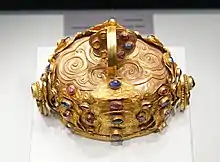
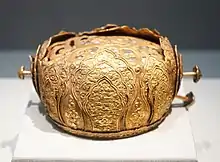
During the later years of the Wanli Emperor's reign, he became thoroughly alienated from his imperial role and, in effect, went on strike. He refused to attend morning meetings, see his ministers or act upon memoranda. He also refused to make necessary personnel appointments, and as a result the whole top echelon of the Ming administration became understaffed. He did, however, pay close attention to the construction of his own tomb, a magnificent structure that took decades to complete.
There are several reasons why the Wanli Emperor deliberately neglected his duties as emperor. One was that he became disenchanted with the moralistic attacks and counterattacks of officials, rooted in an abstract Confucian orthodoxy.[14] A more important reason, though, was a dispute about the imperial succession. The emperor's favorite consort was Noble Consort Zheng, and throughout the 1580s and 1590s, the emperor very much wanted to promote his son by her (Zhu Changxun) as crown prince, even though he was only the emperor's third son and not favored for the succession. Many of his powerful ministers were opposed, and this led to a clash between sovereign and ministers that lasted more than 15 years. In October 1601, the Wanli Emperor finally gave in and promoted Zhu Changluo – the future Taichang Emperor – as crown prince. Although the ministers seem to have triumphed, the Wanli Emperor adopted a policy of passive resistance, refusing to play his part in allowing the government to function adequately, leading to serious problems both within China itself and on the borders.[15] Additionally, the emperor continued to express his objection to the choice of Zhu Changluo as heir apparent, even delaying the burial of Crown Princess Guo by two years, before allowing her to be buried appropriately for the wife of the crown prince.
The area known as Manchuria in northeastern China was gradually conquered by the Jurchen chieftain Nurhaci. Nurhaci would go on to create the Later Jin (the precursor of the Qing dynasty), which would now become an immediate threat to the Ming dynasty. By this time, after 20 years of imperial dysfunction, the Ming army was in decline. The Jurchens were fewer in number, but they were able to upset the Ming. For instance, in the Battle of Sarhū in 1619, the Ming government sent out an army of 200,000 against the Later Jin army of 60,000, with Nurhaci controlling six banners and 45,000 troops as the central attack, while Daišan and Hong Taiji each controlled 7,500 troops and one banner and attacked from the sides. After five days of battle, the Ming army suffered casualties of over 100,000, with 70% of their food supply stolen.
When the Oirats transmitted some descriptions of China to the Russians in 1614, the name "Taibykankan" was used to refer to the Wanli Emperor by the Oirats.[16]
In 1615, the Ming imperial court was hit by yet another scandal. A man named Zhang Chai (張差), armed with only a wooden staff, managed to chase away the eunuchs guarding the gates and broke into Ciqing Palace (慈慶宮), then the crown prince's living quarters. Zhang Chai was eventually subdued and thrown into prison. Initial investigation found him to be a lunatic, but upon further investigation by a magistrate named Wang Zhicai (王之寀), Zhang Chai confessed to being party to a plot instigated by two eunuchs working under Noble Consort Zheng. According to Zhang Chai's confession, the two had promised him rewards for assaulting the Crown Prince, thus implicating the Emperor's favorite concubine in an assassination plot. Presented with the incriminating evidence and the gravity of the accusations, the Wanli Emperor, in an attempt to spare Noble Consort Zheng, personally presided over the case. He laid the full blame on the two implicated eunuchs who were executed along with the would-be assassin. Although the case was quickly hushed up, it did not quash public discussion and eventually became known as the "Case of the Wooden Staff Assault" (梃擊案), one of three notorious 'mysteries' of the late Ming dynasty.
Legacy and death

Some scholars believe that the Wanli Emperor's reign was a significant factor contributing to the decline of the Ming dynasty. He refused to play the emperor's role in government, and delegated many responsibilities to eunuchs, who made up their own faction. The official administration was so dissatisfied that a group of scholars and political activists loyal to the thoughts of Zhu Xi and against those of Wang Yangming created the Donglin movement, a political group who believed in upright morals and tried to influence the government according to strict Neo-Confucian principles.
His reign also experienced heavy fiscal and military pressures, especially during the final years of the Wanli era when the Jurchens began to conduct raids on the northern border of the Ming Empire. Their depredations ultimately led to the fall of the Ming dynasty in 1644. The fall of the Ming dynasty was not a result of the last Ming emperor's Chongzhen Emperor's rule, but instead due to the lingering consequences of the Wanli Emperor's gross neglect of his duties as emperor.
The Wanli Emperor died in 1620 and was buried in the Dingling Mausoleum among the Ming tombs on the outskirts of Beijing. His tomb is one of the biggest in the vicinity and one of only two that are open to the public. The tomb was excavated in 1956, and remains the only imperial tomb that had been excavated since the founding of the People's Republic of China in 1949. In 1966, during the Cultural Revolution, Red Guards stormed the Dingling Mausoleum, and dragged the remains of the Wanli Emperor and his two empresses to the front of the tomb, where they were posthumously denounced and burned after photographs were taken of their skulls.[17] Thousands of other artifacts were also destroyed.[18]
In 1997, China's Ministry of Public Security published a book on the history of drug abuse. It alleged that the Wanli Emperor's remains had been examined in 1958 and found to contain morphine residues at levels which indicate that he had been a heavy and habitual user of opium.[19]
Family
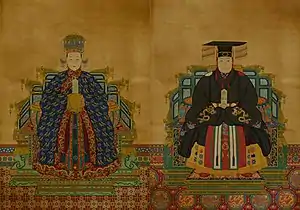
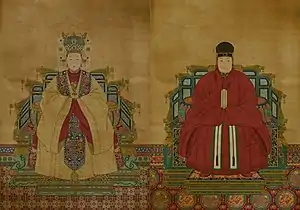
Consorts and Issue:
- Empress Xiaoduanxian, of the Wang clan (孝端顯皇后 王氏; 7 November 1564 – 7 May 1620), personal name Xijie (喜姐)
Titles: Empress (皇后)- Princess Rongchang (榮昌公主; 1582–1647), personal name Xuanying (軒媖), first daughter
- Married Yang Chunyuan (楊春元; 1582–1616) in 1597, and had issue (five sons)
- Princess Rongchang (榮昌公主; 1582–1647), personal name Xuanying (軒媖), first daughter
- Empress Dowager Xiaojing, of the Wang clan (孝靖皇太后 王氏; 27 February 1565 – 18 October 1611)
Titles: Consort Gong (恭妃) → Noble Consort Gong (恭貴妃) → Imperial Noble Consort Cisheng (慈生皇貴妃)- Zhu Changluo, the Taichang Emperor (光宗 朱常洛; 28 August 1582 – 26 September 1620), first son
- Princess Yunmeng (雲夢公主; 1584–1587), personal name Xuanyuan (軒嫄), fourth daughter
- Grand Empress Dowager Xiaoning, of the Zheng clan (孝寧太皇太后 鄭氏; 1565–1630)
Titles: Imperial Concubine Shu (淑嬪) → Consort De (德妃) → Noble Consort (貴妃)- Princess Yunhe (雲和公主; 1584–1590), personal name Xuanshu (軒姝), second daughter
- Zhu Changxu, Prince Ai of Bin (邠哀王 朱常溆; 19 January 1585), second son
- Zhu Changxun, Prince Zhong of Fu (福忠王 朱常洵; 22 February 1586 – 2 March 1641), third son
- Zhu Changzhi, Prince Hai of Yuan (沅懷王 朱常治; 10 October 1587 – 5 September 1588), fourth son
- Princess Lingqiu (靈丘公主; 1588–1589), personal name Xuanyao (軒姚), sixth daughter
- Princess Shouning (壽寧公主; 1592–1634), personal name Xuanwei (軒媁), seventh daughter
- Married Ran Xingrang (冉興讓; d. 1644) in 1609, and had issue (one son)
- Grand Empress Dowager Xiaojing, of the Li clan (孝敬太皇太后 李氏; d. 1597)
Titles: Consort (妃)- Zhu Changrun, Prince of Hui (惠王 朱常潤; 7 December 1594 – 29 June 1646), sixth son
- Zhu Changying, Prince Duan of Gui (桂端王 朱常瀛; 25 April 1597 – 21 December 1645), seventh son
- Consort Xuanyizhao, of the Li clan (宣懿昭妃; 1557–1642)
- Consort Ronghuiyi, of the Yang clan (榮惠宜妃 楊氏; d. 1581)
- Consort Wenjingshun, of the Chang clan (溫靜順妃 常氏; 1568–1594)
- Consort Duanjingrong, of the Wang clan (端靖榮妃 王氏; d. 1591)
- Princess Jingle (靜樂公主; 8 July 1584 – 12 November 1585), personal name Xuangui (軒媯), third daughter
- Consort Zhuangjingde, of the Xu clan (莊靖德妃 許氏; d. 1602)
- Consort Duan, of the Zhou clan (端妃 周氏)
- Zhu Changhao, Prince of Rui (瑞王 朱常浩; 27 September 1591 – 24 July 1644), fifth son
- Consort Qinghuishun, of the Li clan (清惠順妃 李氏; d. 1623)
- Zhu Changpu, Prince Si of Yong (永思王 朱常溥; 1604–1606), eighth son
- Princess Tiantai (天台公主; 1605–1606), personal name Xuanmei (軒媺), tenth daughter
- Consort Xi, of the Wang clan (僖妃 王氏; d. 1589)
- Concubine De, of the Li clan (德嬪 李氏; 1567–1628)
- Princess Xianju (仙居公主; 1584–1585), personal name Xuanji (軒姞), fifth daughter
- Princess Taishun (泰順公主; d. 1593), personal name Xuanji (軒姬), eighth daughter
- Princess Xiangshan (香山公主; 1598–1599), personal name Xuandeng (軒嬁), ninth daughter
- Concubine Shen, of the Wei clan (慎嬪 魏氏; 1567–1606)
- Concubine Jing, of the Shao clan (敬嬪 邵氏; d. 1606)
- Concubine Shun, of the Zhang clan (順嬪 張氏; d. 1589)
- Concubine He, of the Liang clan (和嬪 梁氏; 1562–1643)
- Concubine Dao, of the Geng clan (悼嬪 耿氏; 1568–1589)
- Shiwei, of the Hu clan (侍御 胡氏)
- Noble Lady, of the Guo clan (貴人 郭氏)
Ancestry
| Chenghua Emperor (1447–1487) | |||||||||||||||||||
| Zhu Youyuan (1476–1519) | |||||||||||||||||||
| Empress Xiaohui (d. 1522) | |||||||||||||||||||
| Jiajing Emperor (1507–1567) | |||||||||||||||||||
| Jiang Xiao | |||||||||||||||||||
| Empress Cixiaoxian (d. 1538) | |||||||||||||||||||
| Lady Wu | |||||||||||||||||||
| Longqing Emperor (1537–1572) | |||||||||||||||||||
| Du Lin | |||||||||||||||||||
| Empress Xiaoke (d. 1554) | |||||||||||||||||||
| Wanli Emperor (1563–1620) | |||||||||||||||||||
| Li Gang | |||||||||||||||||||
| Li Yu | |||||||||||||||||||
| Li Wei (1527–1583) | |||||||||||||||||||
| Empress Dowager Xiaoding (1545–1614) | |||||||||||||||||||
| Lady Wang | |||||||||||||||||||
See also
- Chinese emperors family tree (late)
Notes
- Following the death of the emperor, the Wanli era was normally due to end on 21 January 1621. However, the Wanli Emperor's successor, the Taichang Emperor, died within a month, before 22 January 1621, which should have been the start of the Taichang era. The Tianqi Emperor, who succeeded the Taichang Emperor, decided that the Wanli era would be considered as having ended on the last day of the seventh month (equivalent to 27 August 1620), to enable the Taichang era to be applied retrospectively for the remaining five months in that year. Dates before 1582 are given in the Julian calendar, not in the proleptic Gregorian calendar. Dates after 1582 are given in the Gregorian calendar.
References
Citations
- Frederick W. Mote (2003). Imperial China 900-1800. Harvard University Press. pp. 727–. ISBN 978-0-674-01212-7.
- Frederick W. Mote; Denis Twitchett (26 February 1988). The Cambridge History of China: Volume 7, The Ming Dynasty, 1368-1644. Cambridge University Press. pp. 514–. ISBN 978-0-521-24332-2.
- Science and Civilization in China, v.3 pp.425-6; cf. 1587, a Year of No Significance.
- Swope, Kenneth M. (2011). "6 To catch a tiger The Eupression of the Yang Yinglong Miao uprising (1578-1600) as a case study in Ming military and borderlands history". In Aung-Thwin, Michael Arthur; Hall, Kenneth R. (eds.). New Perspectives on the History and Historiography of Southeast Asia: Continuing Explorations. Routledge. pp. 122–125. ISBN 978-1136819643.
- Xie, Xiaohui (2013). "5 From Woman's Fertility to Masculine Authority: The Story of the White Emperor Heavenly Kings in Western Hunan". In Faure, David; Ho, Ts'ui-p'ing (eds.). Chieftains into Ancestors: Imperial Expansion and Indigenous Society in Southwest China (illustrated ed.). UBC Press. pp. 118–120. ISBN 978-0774823715.
- Herman, John E. (2007). Amid the Clouds and Mist: China's Colonization of Guizhou, 1200-1700 (illustrated ed.). Harvard University Asia Center. pp. 164, 165, 281. ISBN 978-0674025912.
- Ness, John Philip (1998). The Southwestern Frontier During the Ming Dynasty. University of Minnesota. pp. 139, 140.
- von Glahn, Richard L.; Glahn, Richard Von (1987). The country of streams and grottoes. pp. 126, 132, 133. ISBN 0674175433.
- Swope, Kenneth (2001). The Three Great Campaigns of the Wanli Emperor, 1592-1600: court, military and society in late sixteenth-century China. University of Michigan. pp. 387, 411, 442. ISBN 9780493331492.
- Liew, Foon Ming, ed. (1998). The Treatises on Military Affairs of the Ming Dynastic History (1368-1644): An Annotated Translation of the Treatises on Military Affairs, Chapter 89 and Chapter 90 : Supplemented by the Treatises on Military Affairs of the Draft of the Ming Dynastic History : a Documentation of Ming ..., Part 1. Vol. 129 of Gesellschaft für Natur- und Völkerkunde Ostasiens: Mitteilungen der Gesellschaft für Natur- und Völkerkunde Ostasiens e.V. Ges.f. Natur-e.V. pp. 271, 274. ISBN 3928463640.
- Hutchison, Sandra (1996). Chinese Brushstrokes: Stories of China (illustrated ed.). Turnstone Press. pp. 22, 23. ISBN 0888012098.
- Ouyang, Xiu (2004). Davis, Richard L. (ed.). Historical Records of the Five Dynasties (illustrated, annotated ed.). Columbia University Press. p. 77. ISBN 0231502281.
- Kuhn, Dieter, ed. (1994). Burial in Song China. Würzburger Sinologische Schriften. Edition Forum. pp. 186, 188, 213. ISBN 3927943096.
- Huang, Ray(1981) 1587, a Year of No Significance: The Ming Dynasty in Decline. New Haven: Yale University Press. ISBN 0-300-02518-1
- Goodrich, Carrington L. & Fang, Chaoying, eds. (1976). Dictionary of Ming Biography. New York: Columbia University Press. ISBN 0-231-03801-1.
- Peter C Perdue (30 June 2009). China Marches West: The Qing Conquest of Central Eurasia. Harvard University Press. pp. 100–. ISBN 978-0-674-04202-5.
- Becker, Jasper (2008). City of Heavenly Tranquility: Beijing in the History of China. Oxford University Press. ISBN 978-0-19-530997-3, pp 77-79.
- "China's reluctant Emperor", The New York Times, Sheila Melvin, Sept. 7, 2011.
- Zheng Yangwen (2005). The Social Life of Opium in China. Cambridge: Cambridge University Press. pp. 18–19. ISBN 0-521-84608-0.